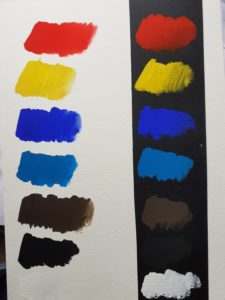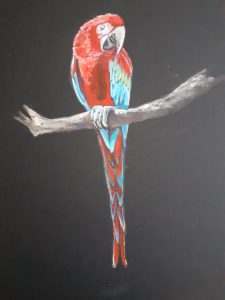
This bright and colourful Macaw was the perfect subject for working with Daler-Rowney Designers’ Gouache (pronounced gwash) to show off the striking plumage. These paints are made from high quality pigments, with excellent covering power and fully intermixable with watercolour. Available in 90 colours in 15ml tubes and 5 colours in 38ml tubes.
Many fine artists, illustrators, graphic designers, animators and mixed media artists will be familiar with Designers’ Gouache in some way, as the White is often used to add highlights to a painting. Gouache is essentially an opaque, vibrant and luminous watercolour paint, which is thicker and more flexible – the possibilities are expanded to be used on colourful or even black backgrounds. Like watercolour it consists of a pigment; a binder, usually gum Arabic; and a white pigment (like chalk) to make these opaque – sometimes called body colour. Opaque paints like these have been used for centuries for illuminating manuscripts and used by great artists like: Henri Matisse, John Singer Sargent, Albrecht Dürer , JMW Turner to name a few.
1 Gouache is fairly versatile and will work perfectly on the Royal Talens Van Gogh Black watercolour paper, using a white pastel pencil to sketch out the details onto the dark paper. Gouache is easy to use you can add water and use like a watercolour or straight from the tube but do not apply it too thickly as the paint will crack.
Gouache is fairly versatile and will work perfectly on the Royal Talens Van Gogh Black watercolour paper, using a white pastel pencil to sketch out the details onto the dark paper. Gouache is easy to use you can add water and use like a watercolour or straight from the tube but do not apply it too thickly as the paint will crack.
2 This is a Green-winged Macaw rather than a scarlet macaw as the upper wing is mostly green rather than the mostly yellow of a Scarlet Macaw. The body of the Macaw was covered with the red, adding a little water to make the paint flow a little easier. It does not need to be applied very evenly as this adds to the texture. At first the colour looks a little dull but as it dries this brightens up (darker colours will dry lighter and lighter colours will dry darker).
This is a Green-winged Macaw rather than a scarlet macaw as the upper wing is mostly green rather than the mostly yellow of a Scarlet Macaw. The body of the Macaw was covered with the red, adding a little water to make the paint flow a little easier. It does not need to be applied very evenly as this adds to the texture. At first the colour looks a little dull but as it dries this brightens up (darker colours will dry lighter and lighter colours will dry darker).
Add blue and green in the wings – using the shape of the brush to create the feathers.
Filling the other colours like the white of the face, the beak, and the feet. The branch the Macaw is sitting on is completed in a wet in wet technique, using clean water wet the area of the branch and drop colours into the wet surface. Gouache is heavier than watercolours so does not flow as readily but you can create interesting textures. Add shape by adding shadows and bringing out lighter toned highlights.
What is fun about Gouache is that any areas which need improving can be either lifted out like a watercolour or painted over with light or dark like you can with an acrylic paint.
3 The Green-winged macaw differs again from the Scarlet Macaw as it has characteristic red lines around the eyes formed by rows of tiny feathers on the otherwise bare white skin patch so add these details into the face. The black can be used to create greys and in and around the beak in eye. Final touches of white will add highlights and definition to shapes.
The Green-winged macaw differs again from the Scarlet Macaw as it has characteristic red lines around the eyes formed by rows of tiny feathers on the otherwise bare white skin patch so add these details into the face. The black can be used to create greys and in and around the beak in eye. Final touches of white will add highlights and definition to shapes.
Once dry, Gouache has a matt smooth finish and the colours are brighter than when they were when wet.
The Lightfast/Permanence ratings of Gouache have been a consideration, as Designers’ Gouache was originally developed for work in folios which are not exposed to light for long periods. But modern Gouache is moving towards being much more lightfast. In the Daler-Rowney Designers’ Gouache range there are colours with ratings of ****(Permanent) with most colours being ***(Normally Permanent) and ** (Moderately Permanent) and a few colours still being *(Fugitive) and prone to fading.
As with any painting, always protect from direct sunlight to reduce colours fading.
Why not have a go at your own Green Winged Macaw using the outline provided.
Happy Painting,
Anita